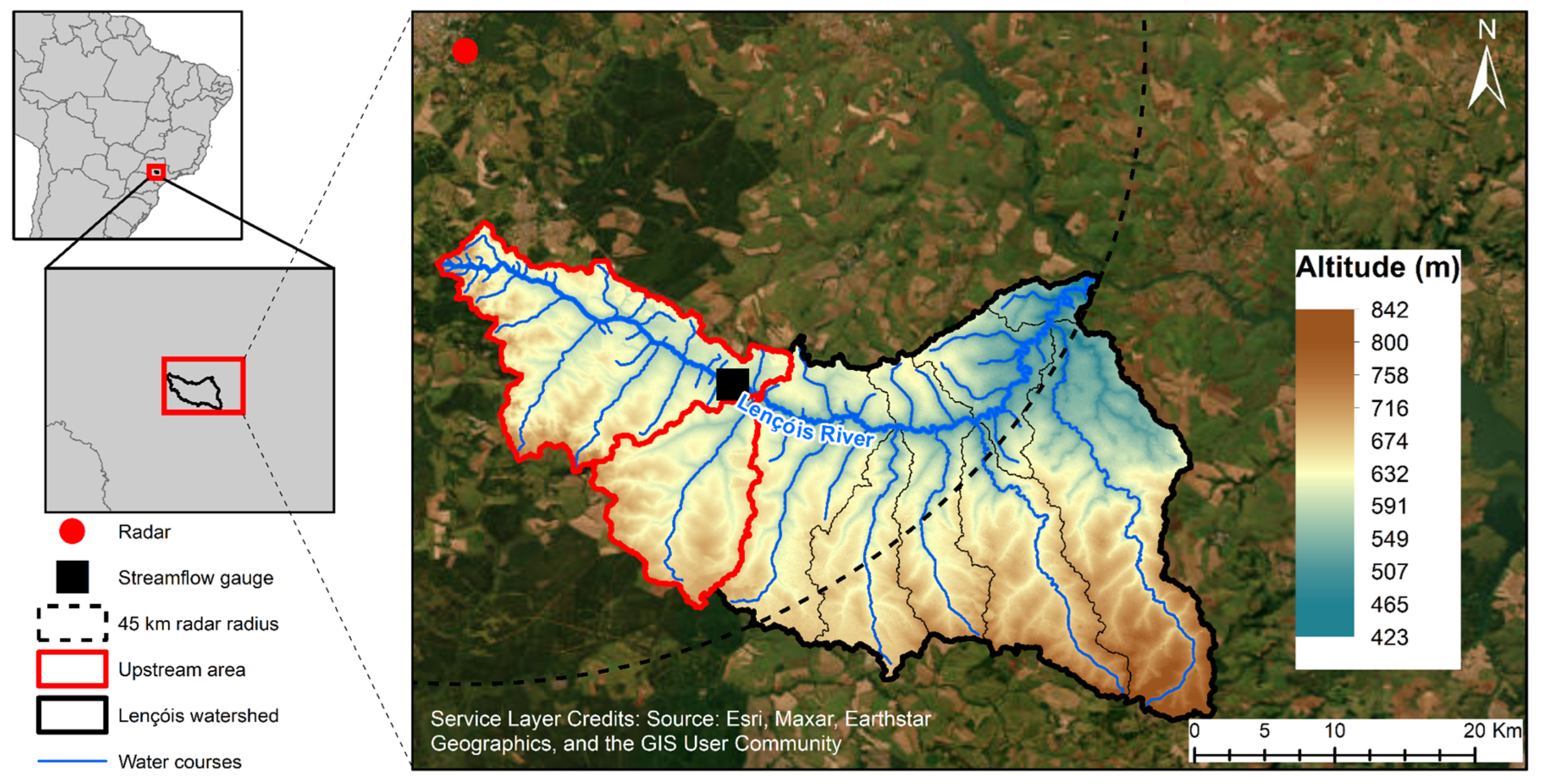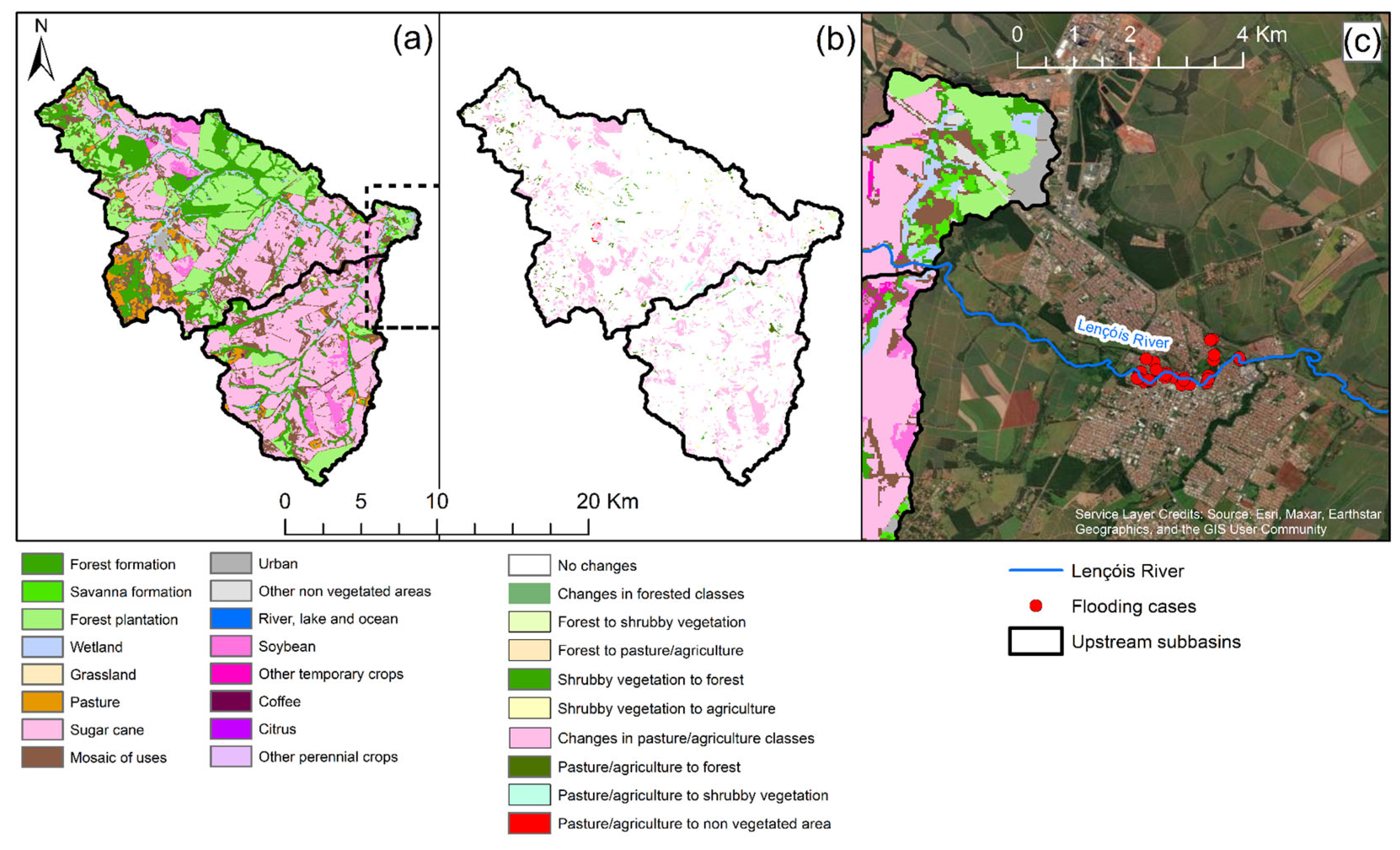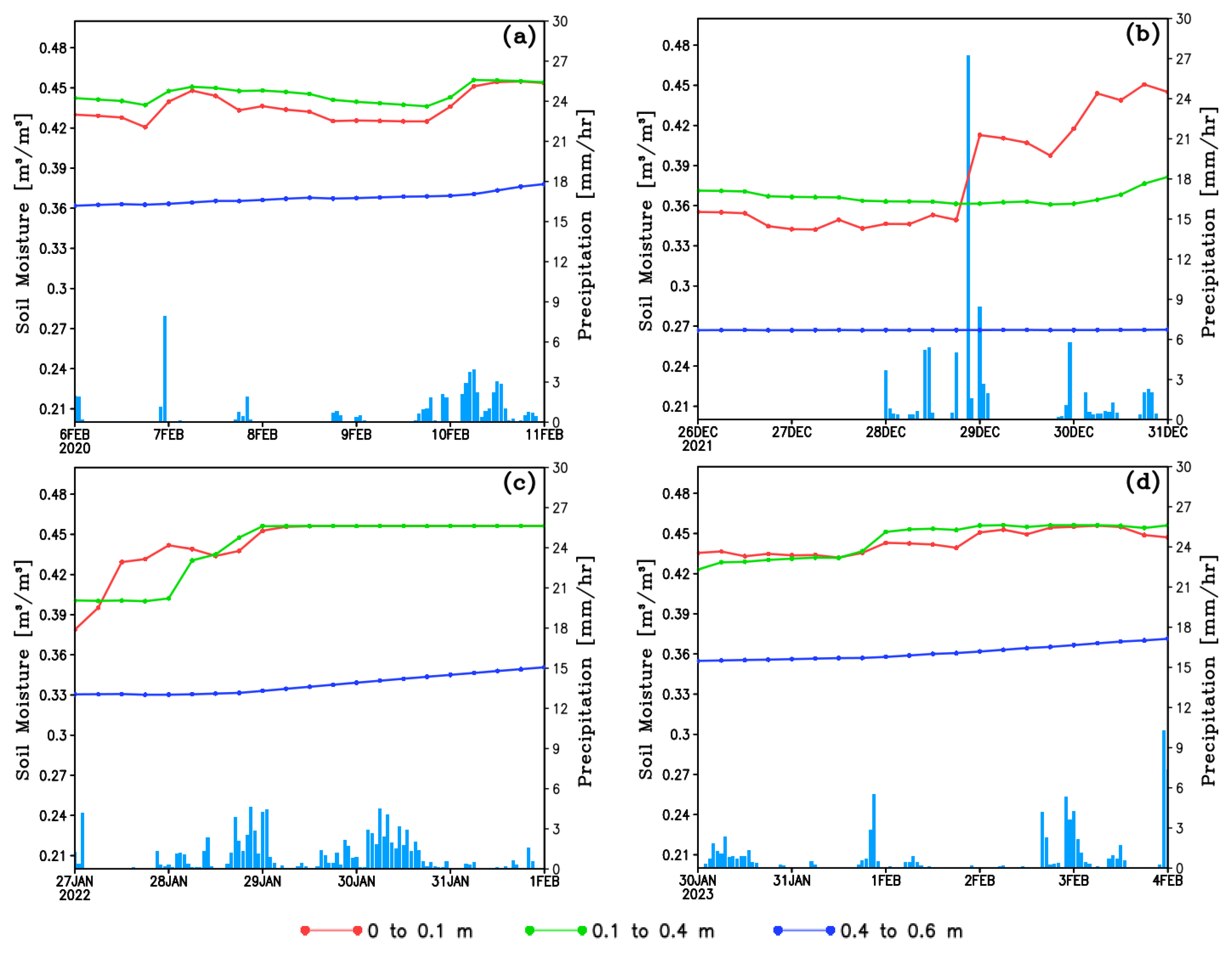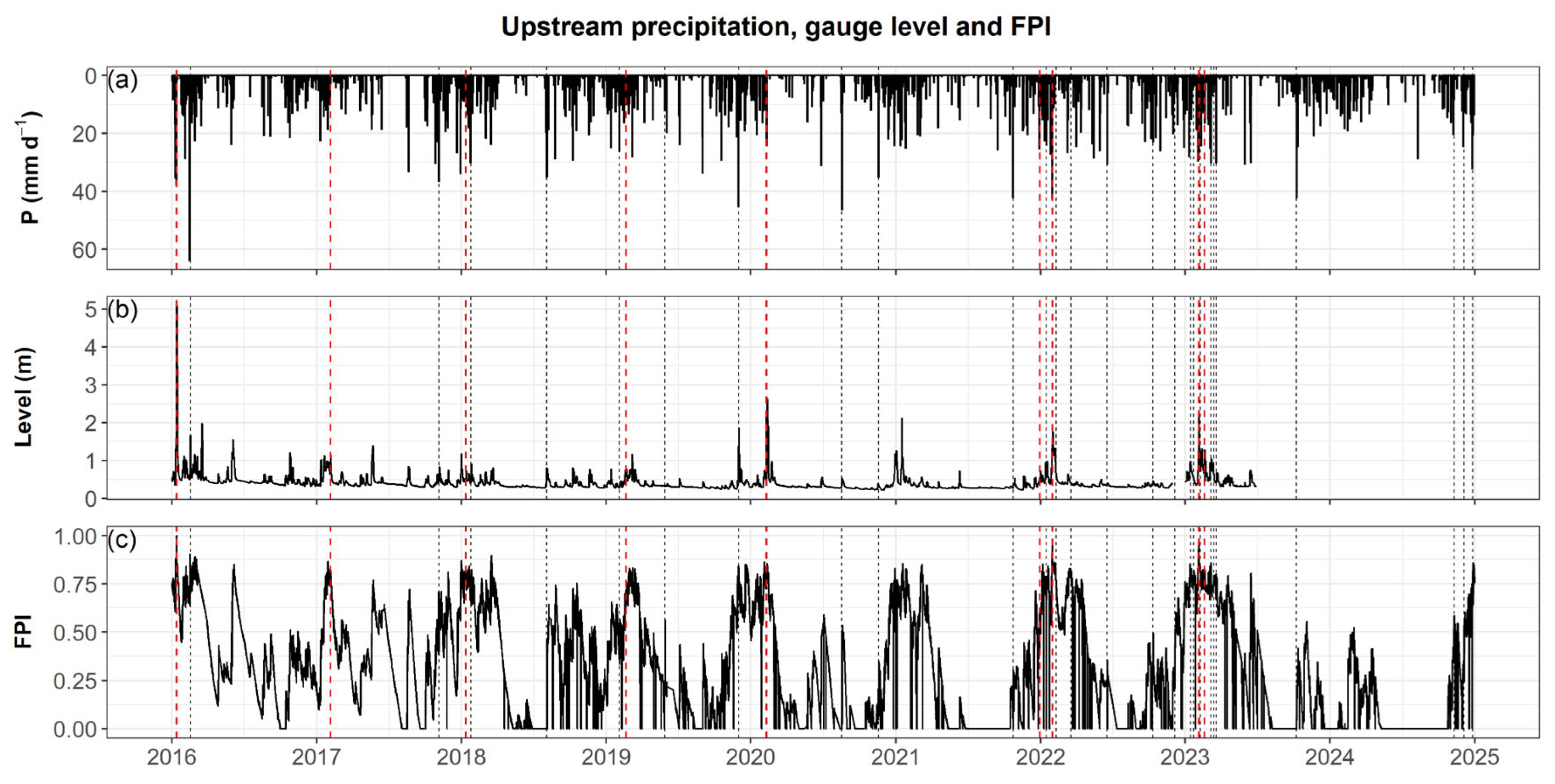A Novel Flood Probability Index Based on Radar Rainfall and Soil Moisture Estimates for a Small Vegetated Watershed in Southeast Brazil
Abstract
1. Introduction
2. Material and Methods
2.1. Study Area
2.2. Radar-Based Estimation of Precipitation
2.3. Soil Moisture Simulation with JULES Model
2.4. Selection of Parameters Used in FPI Calculation
2.5. Selection of Cases with Flooding
2.6. Selection of Cases Without Flooding
2.7. Flood Probability Index Calculation
3. Results
4. Discussion
5. Conclusions
Author Contributions
Funding
Institutional Review Board Statement
Informed Consent Statement
Data Availability Statement
Acknowledgments
Conflicts of Interest
References
- Pörtner, H.-O.; Roberts, D.C.; Tignor, M.; Poloczanska, E.; Mintenbeck, K.; Alegría, A.; Craig, M.; Langsdorf, S.; Löschke, S.; Möller, V. Working Group II Contribution to the Sith Assessment Report of the Intergovernmental Panel on Climate Change. In IPPC 2022: Climate Change 2022: Impacts, Adaptation and Vulnerability; Cambridge University Press: Cambridge, UK, 2022. [Google Scholar]
- Collischonn, E. Inundações Em Venâncio Aires/RS: Interações Entre as Dinâmicas Natural e Social Na Formação de Riscos Socioambientais Urbanos. Ph.D. Thesis, Universidade Federal de Santa Catarina, Florianópolis, Brazil, 2009. [Google Scholar]
- Silvestro, F.; Rossi, L.; Campo, L.; Parodi, A.; Fiori, E.; Rudari, R.; Ferraris, L. Impact-Based Flash-Flood Forecasting System: Sensitivity to High Resolution Numerical Weather Prediction Systems and Soil Moisture. J. Hydrol. 2019, 572, 388–402. [Google Scholar] [CrossRef]
- de Oliveira Silva, L.A.; Castro, J.F.M.; Bueno, G.T. Fatores Intensificadores Das Enchentes/Inundações No Médio e Baixo Rio Piranga–MG. CLIMEP-Climatol. Estud. Paisag. 2016, 9, 18–41. [Google Scholar]
- Collischonn, W.; Dornelles, F. Hidrologia Para Engenharia e Ciências Ambientais; Associação Brasileira de Recursos Hídricos, ABRHidro: Porto Alegre, Brazil, 2013; 336p. [Google Scholar]
- Ye, S.; Wang, J.; Ran, Q.; Chen, X.; Liu, L. The Relative Importance of Antecedent Soil Moisture and Precipitation in Flood Generation in the Middle and Lower Yangtze River Basin. Hydrol. Earth Syst. Sci. Discuss. 2021, 2021, 1–35. [Google Scholar]
- Yu, T.; Ran, Q.; Pan, H.; Li, J.; Pan, J.; Ye, S. The Impacts of Rainfall and Soil Moisture to Flood Hazards in a Humid Mountainous Catchment: A Modeling Investigation. Front. Earth Sci. 2023, 11, 1285766. [Google Scholar] [CrossRef]
- Kidd, C.; Huffman, G. Global Precipitation Measurement. Meteorol. Appl. 2011, 18, 334–353. [Google Scholar] [CrossRef]
- Adilson Moreira, I.; Moro Mine, M.; Pereira Filho, A. Modelagem Hidrológica Chuva-Vazão Com Dados de Radar e Pluviômetros. Ing. Agua 2007, 14, 83–96. [Google Scholar] [CrossRef]
- Wilson, J.W.; Crook, N.A.; Mueller, C.K.; Sun, J.; Dixon, M. Nowcasting Thunderstorms: A Status Report. Bull. Am. Meteorol. Soc. 1998, 79, 2079–2099. [Google Scholar] [CrossRef]
- Drumond, R.A.S.; Almeida, R.P.; de Nascimento, N.O. Mudanças Climáticas e Plano Diretor: Mitigação de Inundações Em Belo Horizonte. Cad. Metrópole 2023, 25, 899–922. [Google Scholar] [CrossRef]
- Ferreira, M.J.; da Rocha, H.R. Green Roof Infrastructure Outperforms Grey Technology in Flood Mitigation in São Paulo’s Urbanized Region. Front. Built Environ. 2023, 9, 1254942. [Google Scholar] [CrossRef]
- dos Santos, F.M.; de Souza Pelinson, N.; de Oliveira, R.P.; Di Lollo, J.A. Using the SWAT Model to Identify Erosion Prone Areas and to Estimate Soil Loss and Sediment Transport in Mogi Guaçu River Basin in Sao Paulo State, Brazil. Catena 2023, 222, 106872. [Google Scholar] [CrossRef]
- Lopes, T.R.; Folegatti, M.V.; Duarte, S.N.; Zolin, C.A.; Junior, L.S.F.; Moura, L.B.; Oliveira, R.K.; Santos, O.N.A. Hydrological Modeling for the Piracicaba River Basin to Support Water Management and Ecosystem Services. J. S. Am. Earth Sci. 2020, 103, 102752. [Google Scholar] [CrossRef]
- Domingues, L.M.; de Abreu, R.C.; da Rocha, H.R. Hydrologic Impact of Climate Change in the Jaguari River in the Cantareira Reservoir System. Water 2022, 14, 1286. [Google Scholar] [CrossRef]
- Tramblay, Y.; Bouaicha, R.; Brocca, L.; Dorigo, W.; Bouvier, C.; Camici, S.; Servat, É. Estimation of Antecedent Wetness Conditions for Flood Modelling in Northern Morocco. Hydrol. Earth Syst. Sci. 2012, 16, 4375–4386. [Google Scholar] [CrossRef]
- Seiler, R.; Hayes, M.; Bressan, L. Using the Standardized Precipitation Index for Flood Risk Monitoring. Int. J. Climatol. 2002, 22, 1365–1376. [Google Scholar] [CrossRef]
- Popa, M.C.; Peptenatu, D.; Drăghici, C.C.; Diaconu, D.C. Flood Hazard Mapping Using the Flood and Flash-Flood Potential Index in the Buzău River Catchment, Romania. Water 2019, 11, 2116. [Google Scholar] [CrossRef]
- Rosmadi, H.; Ahmed, M.; Mokhtar, M.; Lim, C. Reviewing Challenges of Flood Risk Management in Malaysia. Water 2023, 15, 2390. [Google Scholar] [CrossRef]
- Bang, H.N.; Burton, N.C. Contemporary Flood Risk Perceptions in England: Implications for Flood Risk Management Foresight. Clim. Risk Manag. 2021, 32, 100317. [Google Scholar] [CrossRef]
- Lee, H.; Calvin, K.; Dasgupta, D.; Krinner, G.; Mukherji, A.; Thorne, P.; Trisos, C.; Romero, J.; Aldunce, P.; Barrett, K. Climate Change 2023: Synthesis Report. Contribution of Working Groups I, II and III to the Sixth Assessment Report of the Intergovernmental Panel on Climate Change; The Australian National University: Canberra, Australia, 2023; ISBN 92-9169-164-X. [Google Scholar]
- Chitwatkulsiri, D.; Miyamoto, H. Real-Time Urban Flood Forecasting Systems for Southeast Asia—A Review of Present Modelling and Its Future Prospects. Water 2023, 15, 178. [Google Scholar] [CrossRef]
- Ringo, J.; Sabai, S.; Mahenge, A. Performance of Early Warning Systems in Mitigating Flood Effects. A Review. J. Afr. Earth Sci. 2024, 210, 105134. [Google Scholar] [CrossRef]
- Souza, C.M., Jr.; Shimbo, J.Z.; Rosa, M.R.; Parente, L.L.; Alencar, A.A.; Rudorff, B.F.; Hasenack, H.; Matsumoto, M.; Ferreira, L.G.; Souza-Filho, P.W. Reconstructing Three Decades of Land Use and Land Cover Changes in Brazilian Biomes with Landsat Archive and Earth Engine. Remote Sens. 2020, 12, 2735. [Google Scholar] [CrossRef]
- de Oliveira Emídio, Z.P. Impacto Do Balanço Hídrico Em Diferentes Tipos de Solos: Comparação Entre Dados de Radar-Pluviômetro e Análise de Tendência Da Chuva Média Em Área Agrícola. Ph.D. Thesis, Universidade Estadual Paulista (Unesp), Rio Claro, Brazil, 2008. [Google Scholar]
- Emidio, Z.P.; Landim, P.M.B. Análise de superfície de tendência aplicada à chuva medida por radar meteorológico nas regiões de Assis e Piracicaba, SP. Geociências 2008, 27, 439–449. [Google Scholar]
- Marshall, J.S.; Langille, R.C.; Palmer, W.M.K. Measurement of Rainfall by Radar. J. Meteorol. 1947, 4, 186–192. [Google Scholar] [CrossRef]
- Jones, D.M.A. Rainfall Drop-Size Distribution and Radar Reflectivity; Urban Meteorology Laboratory, State Water Survey: Urbana, IL, USA, 1956; pp. 1–20. [Google Scholar]
- Best, M.J.; Pryor, M.; Clark, D.B.; Rooney, G.G.; Essery, R.L.H.; Ménard, C.B.; Edwards, J.M.; Hendry, M.A.; Porson, A.; Gedney, N.; et al. The Joint UK Land Environment Simulator (JULES), Model Description—Part 1: Energy and Water Fluxes. Geosci. Model Dev. 2011, 4, 677–699. [Google Scholar] [CrossRef]
- Clark, D.B.; Mercado, L.M.; Sitch, S.; Jones, C.D.; Gedney, N.; Best, M.J.; Pryor, M.; Rooney, G.G.; Essery, R.L.H.; Blyth, E.; et al. The Joint UK Land Environment Simulator (JULES), Model Description—Part 2: Carbon Fluxes and Vegetation Dynamics. Geosci. Model Dev. 2011, 4, 701–722. [Google Scholar] [CrossRef]
- Borges, I.V.G.; Moreira, D.S.; Rozante, J.R. Precipitation Field from Rainfall Measurements and Rainfall Estimates from IPMet’s Radars. Anuário Inst. Geociências-UFRJ 2019, 42, 417–426. [Google Scholar] [CrossRef]
- Schleiss, M.; Olsson, J.; Berg, P.; Niemi, T.; Kokkonen, T.; Thorndahl, S.; Nielsen, R.; Ellerbæk Nielsen, J.; Bozhinova, D.; Pulkkinen, S. The Accuracy of Weather Radar in Heavy Rain: A Comparative Study for Denmark, the Netherlands, Finland and Sweden. Hydrol. Earth Syst. Sci. 2020, 24, 3157–3188. [Google Scholar] [CrossRef]
- Ahlmer, A.-K.; Cavalli, M.; Hansson, K.; Koutsouris, A.J.; Crema, S.; Kalantari, Z. Soil Moisture Remote-Sensing Applications for Identification of Flood-Prone Areas along Transport Infrastructure. Environ. Earth Sci. 2018, 77, 533. [Google Scholar] [CrossRef]
- Wallace, E.E.; Chappell, N.A. A Statistical Comparison of Spatio-temporal Surface Moisture Patterns beneath a Semi-natural Grassland and Permanent Pasture: From Drought to Saturation. Hydrol. Process. 2020, 34, 3000–3020. [Google Scholar] [CrossRef]





| Date | Local Time | Event Description |
|---|---|---|
| 12 January 2016 | 22:00 | The worst flood of the Lençóis River on record, resulting from an extreme rainfall event of 213 mm in a few hours. More than 1342 people were affected, with 997 left homeless and approximately USD 17 million in losses. Besides the rain, the main causes of the flooding were soil saturation, rupture of dams and reservoirs, and water coming from contour lines (SIDEC). |
| 5 February 2017 | 19:00 | Although it did not rain in the urban area on that day, there was a low-amplitude flood in isolated points of the Lençóis River due to the accumulated precipitation of 197 mm in the 24 h preceding the event (SIDEC). |
| 11 January 2018 | 14:00 | Tree falls, gradual flooding, waterlogging, vehicle damage, and disruptions in electricity and water supply were reported (IPMet). https://sampi.net.br/bauru/noticias/2201287/regional/2018/01/temporal-de-grande-intensidade--testa--o-sistema-antienchentes-em-lencois-paulista (accessed on 19 May 2025). |
| 20 February 2019 | 14:00 | Overflow of rivers and streams, gradual flooding, floods, waterlogging, landslides/cracks/damage to properties, traffic congestion/public road blockage, vehicle damage, flash floods and sudden inundations (IPMET). https://g1.globo.com/sp/bauru-marilia/noticia/2019/02/20/chuva-deixa-ruas-alagadas-em-lencois-paulista.ghtml (accessed on 19 May 2025). |
| 10 February 2020 | 11:00 | Overflowing of rivers and streams, gradual flooding, flash floods, waterlogging, landslides/cracks/damage to properties, traffic congestion/road closures, disruptions in electricity and water supply, erosion/sinkholes, pavement damage, runoff, and sudden flooding were recorded (IPMet). https://jornaloeco.com.br/cotidiano/corrego-corvo-branco-tem-principio-de-alagamento/#google_vignette (accessed on 19 May 2025). |
| 30 December 2021 | 15:30 | Heavy rainfall caused flooding in Vila Contente, Av. Vinte e Cinco de Janeiro, in the city center, and overflowed the Lençóis River at the Service for Water and Sewage (SAAE) yard, on Atílio Frezarin Street in Vila Morumbi, Inácio Anselmo Street, and São Paulo Street in Mamedina (SIDEC). |
| 31 January 2022 | 02:00 | High rainfall observed in Lençóis Paulista and the surroundings, with notable values in Agudos, Borebi, and Lençóis Paulista. Lençóis River level rose slowly throughout the night. At 4:30 AM on 31 January 2022, the Contingency Plan for Floods and Inundations was activated, and the evacuation of properties near the river was carried out (SIDEC). |
| 3 February 2023 | 22:22 | According to the monitoring system, over 70 mm fell in the last few hours, causing runoff, flooding, and water accumulation in various areas. The Civil Defense authorities reported that the Lençóis River remained within its channel, except at more sensitive points. Source: https://jornaloeco.com.br/cidade/chuva-causa-alagamentos-em-regioes-de-lencois-paulista/ (accessed on 19 May 2025). |
| 18 February 2023 | 18:00 | Intense short-duration rainfall (85 mm between 6 PM and 7 PM, with a daily total of 120.6 mm), deficiency in the micro-drainage of stormwater, and overflow of the Corvo Branco stream channel in Vila Contente, as well as the overflow of the Rio Lençóis channel in Jardim Morumbi, Centro, Vila Mamedina, and Vila Repke (SIDEC). |
| 0.390 | 0.405 | 0.392 | 0.333 | 6.112 | 1.361 | 1.049 | 1.049 | 0.755 |
| o | ||||||||
|---|---|---|---|---|---|---|---|---|
| 0.05 | 0.36 | 0.53 | 0.01 | 0.01 | 0.02 | 0.00 | 0.01 | 0.01 |
| Date | FPI |
|---|---|
| 12 January 2016 | 1.000 |
| 5 February 2017 | 0.818 |
| 11 January 2018 | 0.771 |
| 20 February 2019 | 0.662 |
| 10 February 2020 | 0.824 |
| 30 December 2021 | 0.567 |
| 31 January 2022 | 0.902 |
| 3 February 2023 | 0.961 |
| 18 February 2023 | 0.833 |
| Threshold | Chance of Flooding | Occurrence of Events/Cases | |
|---|---|---|---|
| Events of Flooding | All Cases Outside Flood Periods | ||
| FPI 0.563 | Low | 0% (0 events) | 70% (219,369 cases) |
| 0.563 FPI 0.783 | Moderate | 33% (3 events) | 25% (78,517 cases) |
| 0.783 FPI 0.905 | High | 44% (4 events) | 5% (15,784 cases) |
| FPI 0.905 | Very high | 22% (2 events) | 0.0% (0 cases) |
Disclaimer/Publisher’s Note: The statements, opinions and data contained in all publications are solely those of the individual author(s) and contributor(s) and not of MDPI and/or the editor(s). MDPI and/or the editor(s) disclaim responsibility for any injury to people or property resulting from any ideas, methods, instructions or products referred to in the content. |
© 2025 by the authors. Licensee MDPI, Basel, Switzerland. This article is an open access article distributed under the terms and conditions of the Creative Commons Attribution (CC BY) license (https://creativecommons.org/licenses/by/4.0/).
Share and Cite
Lopes, T.G.; Freitas, H.C.d.; Domingues, L.M.; Moreira, D.S. A Novel Flood Probability Index Based on Radar Rainfall and Soil Moisture Estimates for a Small Vegetated Watershed in Southeast Brazil. Atmosphere 2025, 16, 633. https://doi.org/10.3390/atmos16060633
Lopes TG, Freitas HCd, Domingues LM, Moreira DS. A Novel Flood Probability Index Based on Radar Rainfall and Soil Moisture Estimates for a Small Vegetated Watershed in Southeast Brazil. Atmosphere. 2025; 16(6):633. https://doi.org/10.3390/atmos16060633
Chicago/Turabian StyleLopes, Thaísa Giovana, Helber Custódio de Freitas, Leonardo Moreno Domingues, and Demerval Soares Moreira. 2025. "A Novel Flood Probability Index Based on Radar Rainfall and Soil Moisture Estimates for a Small Vegetated Watershed in Southeast Brazil" Atmosphere 16, no. 6: 633. https://doi.org/10.3390/atmos16060633
APA StyleLopes, T. G., Freitas, H. C. d., Domingues, L. M., & Moreira, D. S. (2025). A Novel Flood Probability Index Based on Radar Rainfall and Soil Moisture Estimates for a Small Vegetated Watershed in Southeast Brazil. Atmosphere, 16(6), 633. https://doi.org/10.3390/atmos16060633







